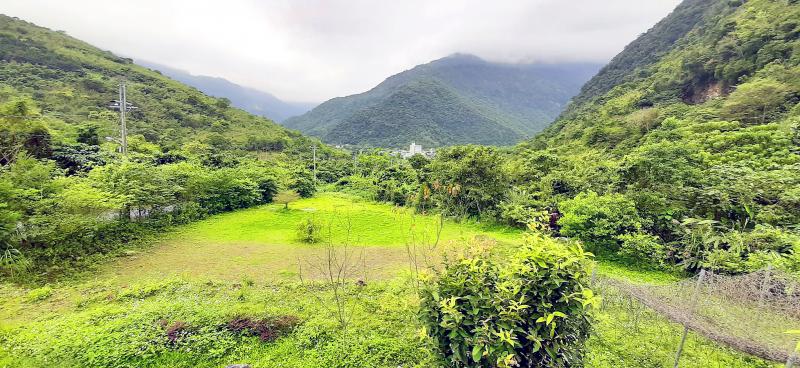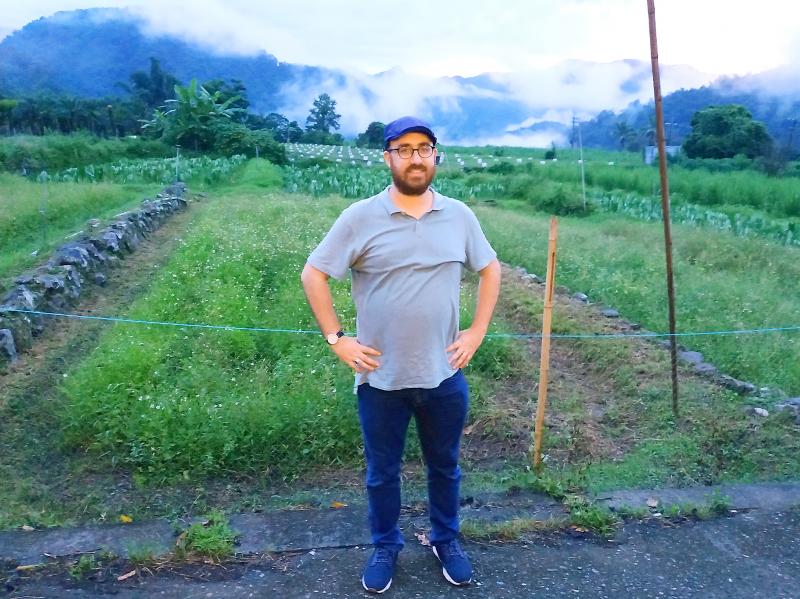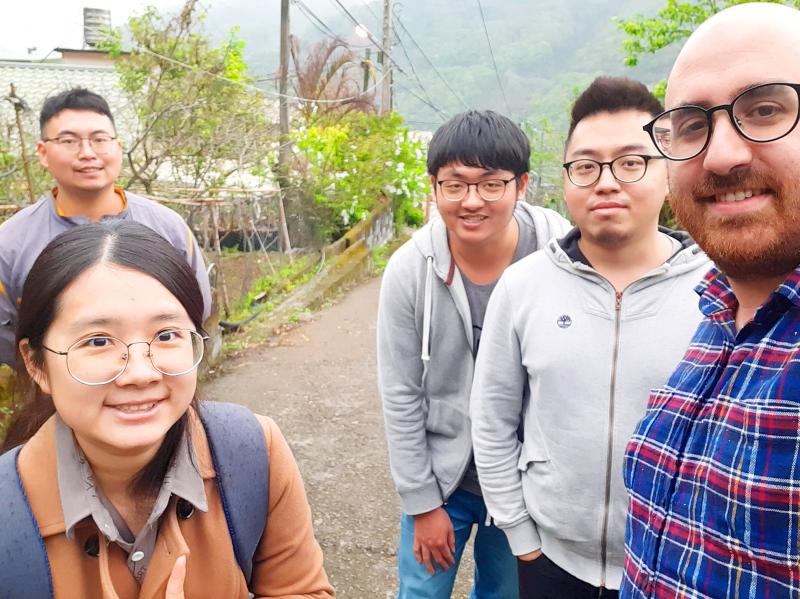We’ve wrapped up our interview and are walking to get coffee when Mucahid Bayrak points to a People’s Republic of China flag. It hangs from an apartment balcony near National Taiwan Normal University (NTNU), where Bayrak is an assistant professor in the Department of Geography.
“In Taiwan, you can do something like that, unlike in much of Asia,” he says, underscoring a point he’d made during our conversation.
I reached out to Bayrak late last year, after coming across a paper he’d recently lead-authored, titled “The effect of cultural practices and perceptions on global climate change response among Indigenous peoples: a case study on the [At]ayal people in northern Taiwan” and published in Environmental Research Letters.

Photo courtesy of Mucahid Bayrak
The Atayal (泰雅) are one of 16 Aboriginal communities recognized by the government. Aboriginal people account for 2.4 percent of the country’s population.
The first sentence of the paper, which Bayrak wrote with two NTNU colleagues, acknowledges that Aboriginal peoples “are disproportionately affected by climate change.”
Given his non-Han name, I wondered if Bayrak was himself Aboriginal. He isn’t, it turns out.

Photo courtesy of Mucahid Bayrak
A Dutchman with Turkish ancestry, Bayrak did research among Vietnam’s indigenous people (the so-called Montagnards) for his PhD studies at the Chinese University of Hong Kong. He describes himself as “passionate about forest dependent communities, conservation initiatives and sustainable livelihood development.”
Bayrak, who joined NTNU’s faculty in 2018, has conducted extensive surveys and interviews among Atayal residents (and some of their Han-Taiwanese neighbors) in Taoyuan’s Fusing District (復興) and Yilan County’s Nanao Township (南澳) to understand their attitudes towards climate change.
“Cultural dimensions and perceptions certainly matter,” he says. “If you talk to indigenous people — and not only in Taiwan — there’s a divide between the climate-change discourses they get from the media or their government, and their own observations,” he says.

Photo courtesy of Mucahid Bayrak
Bayrak says one reason why there isn’t always a strong link between what Aboriginal people report seeing with their own eyes and the picture of global climate change they get from TV or the Internet is that local observations often go beyond the lifetime of the interviewee.
He’s noticed that, when discussing current conditions, it isn’t uncommon for Aboriginal people to reference what happened in their parents’ or grandparents’ time.
“Indigenous knowledge is often communicated through songs, stories and rituals,” says Bayrak. “Compared to science, the way in which cultures generate, disseminate and perceive knowledge is broader.”
TRADITION VS MODERNITY
It’s important to recognize the contrast between traditional Aboriginal beliefs and what’s variously called modern, industrialized or Western thinking, he argues.
The latter, influenced by Western ontologies of nature, “includes elements of ‘God created this world for you, so go ahead and take what’s yours,’ whereas non-monotheistic or indigenous worldviews often teach: ‘You’re not the center of the world, you’re part of it. If you take care of this environment, it’ll take care of you,’” he says.
To stress the relationship Taiwan’s Aboriginal people have traditionally had with their land, some Aboriginal scholars have imported the Australian Aboriginal concept of “country.” This doesn’t refer to the modern state, but rather the terrain, the living things and spirits which inhabit it, its as well as its myths and seasons.
Bayrak describes this as “a very valuable idea.”
“When you can understand what environmental change means for people’s worldviews, you put indigenous people on a more equal footing, because you’re not taking ‘Western’ science as your point of departure, but rather indigenous knowledge is your point of departure,” he says.
“We should treasure these different forms of knowledge. They might conflict at times, but we should acknowledge that there are multiple ways of looking at the environment. At the same time, saying ‘indigenous people are at one with nature’ is too simplistic.”
Bayrak stresses that many indigenous communities have great flexibility when it comes to dealing with change. Many Atayal perceive dramatic climate-related events not necessarily as disasters, but rather as natural — and sometimes even desirable — phenomena, he says.
The “Cultural practices and perceptions” paper quotes an Atayal farmer as asserting that if typhoons don’t strike the mountains, the problem of bees attacking people becomes more serious.
When Aboriginal peoples engage in commercial agriculture, they lose some of their flexibility.
“I’ve seen that with indigenous farmers growing rubber or coffee in Vietnam, and with fruit farmers in Fusing,” says Bayrak.
As the paper points out, Fusing’s peach farmers lost almost their entire 2019 harvest because of unseasonably warm conditions that February. One interviewee told to researchers that the weather “is becoming more unpredictable each year.”
Bayrak says that when Aboriginal communities are given the right to control their hunting grounds or waterways, they’re often very effective at managing them sustainably.
Danaiku (達娜伊谷) near Alishan (阿里山), where the community has worked together to protect river resources and establish an ecotourism park, is an excellent example, he says.
However, successes like Danaiku or Smangus (司馬庫斯) in Hsinchu County can limit the space for experimentation elsewhere.
“Those two places are often held up as model villages. Other indigenous villages are expected to behave just like them, and replicate the model,” Bayrak says.
If Bayrak is more optimistic than some observers about the future of Taiwan’s Aboriginal minority, in part it’s because of the country’s political plurality.
Several of the resettlement communities where Aboriginal people were encouraged to relocate following 2009’s Typhoon Morakot remind Bayrak of the fake made-for-TV town in the movie The Truman Show.
“But at least they triggered a debate about the cultural aspects of disaster recovery and reconstruction. In some parts of the Asia Pacific, there’s no way a discussion like this could happen. They’d resettle you — and, if you’re critical, they’d lock you up,” he says.
“In liberal democracies, there’s more discussion about indigenous people’s rights, and trying to undo historical injustices. In the Asia-Pacific, Taiwan has been at the forefront of this discussion, on a par with New Zealand,” he says, asking: “Just as marriage equality and the government’s response to COVID-19 have enhanced Taiwan’s reputation, is there a way we can put Taiwan on the global map for indigenous peoples’ rights?”
Steven Crook, the author or co-author of four books about Taiwan, has been following environmental issues since he arrived in the country in 1991. He drives a hybrid and carries his own chopsticks.

On April 26, The Lancet published a letter from two doctors at Taichung-based China Medical University Hospital (CMUH) warning that “Taiwan’s Health Care System is on the Brink of Collapse.” The authors said that “Years of policy inaction and mismanagement of resources have led to the National Health Insurance system operating under unsustainable conditions.” The pushback was immediate. Errors in the paper were quickly identified and publicized, to discredit the authors (the hospital apologized). CNA reported that CMUH said the letter described Taiwan in 2021 as having 62 nurses per 10,000 people, when the correct number was 78 nurses per 10,000

As Donald Trump’s executive order in March led to the shuttering of Voice of America (VOA) — the global broadcaster whose roots date back to the fight against Nazi propaganda — he quickly attracted support from figures not used to aligning themselves with any US administration. Trump had ordered the US Agency for Global Media, the federal agency that funds VOA and other groups promoting independent journalism overseas, to be “eliminated to the maximum extent consistent with applicable law.” The decision suddenly halted programming in 49 languages to more than 425 million people. In Moscow, Margarita Simonyan, the hardline editor-in-chief of the

Six weeks before I embarked on a research mission in Kyoto, I was sitting alone at a bar counter in Melbourne. Next to me, a woman was bragging loudly to a friend: She, too, was heading to Kyoto, I quickly discerned. Except her trip was in four months. And she’d just pulled an all-nighter booking restaurant reservations. As I snooped on the conversation, I broke out in a sweat, panicking because I’d yet to secure a single table. Then I remembered: Eating well in Japan is absolutely not something to lose sleep over. It’s true that the best-known institutions book up faster

Though the total area of Penghu isn’t that large, exploring all of it — including its numerous outlying islands — could easily take a couple of weeks. The most remote township accessible by road from Magong City (馬公市) is Siyu (西嶼鄉), and this place alone deserves at least two days to fully appreciate. Whether it’s beaches, architecture, museums, snacks, sunrises or sunsets that attract you, Siyu has something for everyone. Though only 5km from Magong by sea, no ferry service currently exists and it must be reached by a long circuitous route around the main island of Penghu, with the